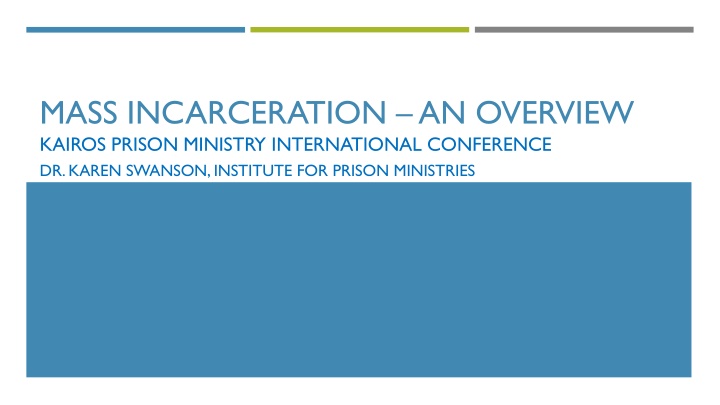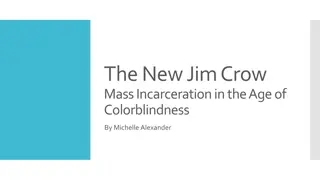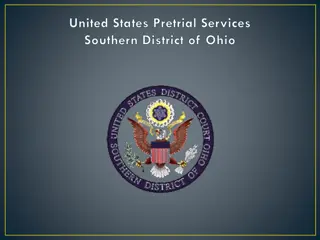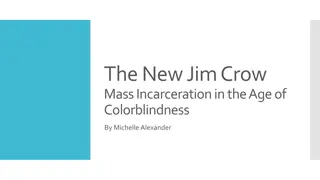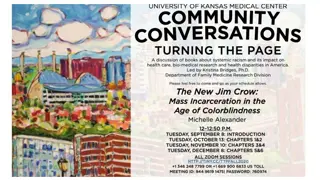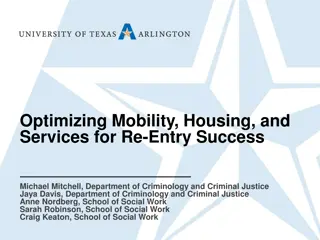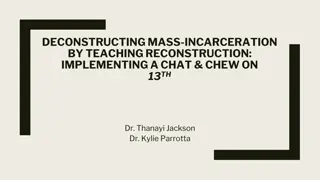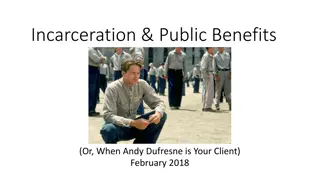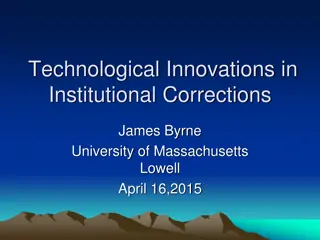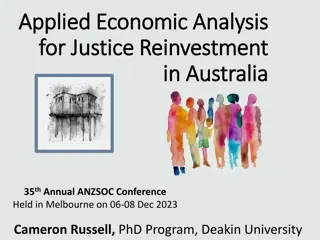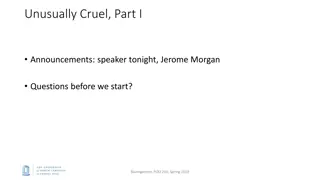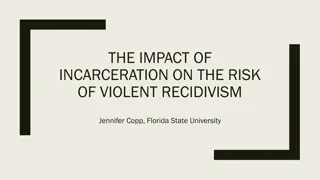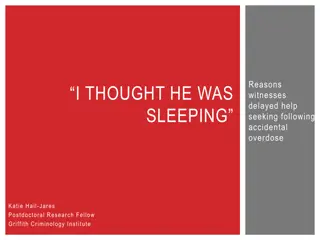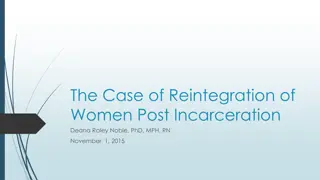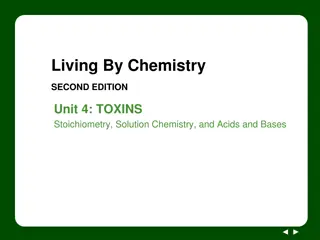Overview of Mass Incarceration Trends
Explore statistics and insights on mass incarceration worldwide, focusing on the U.S. prison system, gender disparities, and international comparison in a thought-provoking presentation.
Download Presentation

Please find below an Image/Link to download the presentation.
The content on the website is provided AS IS for your information and personal use only. It may not be sold, licensed, or shared on other websites without obtaining consent from the author.If you encounter any issues during the download, it is possible that the publisher has removed the file from their server.
You are allowed to download the files provided on this website for personal or commercial use, subject to the condition that they are used lawfully. All files are the property of their respective owners.
The content on the website is provided AS IS for your information and personal use only. It may not be sold, licensed, or shared on other websites without obtaining consent from the author.
E N D
Presentation Transcript
MASS INCARCERATION AN OVERVIEW KAIROS PRISON MINISTRY INTERNATIONAL CONFERENCE DR. KAREN SWANSON, INSTITUTE FOR PRISON MINISTRIES
TEST YOUR KNOWLEDGE Which country locks up more of its people? a) U.S. b) Canada c) Rwanda d) Russia
POPULATION UNDER CONTROL OF THE U.S.CORRECTIONS SYSTEM, 1980 AND 2016 (BJS, 2018) 4,000,000 3,500,000 3,000,000 2,500,000 2,000,000 1,500,000 1,000,000 500,000 0 Prison Jail Parole Probation 1980 2016
TEST YOUR KNOWLEDGE What percentage of the incarcerated in the U.S. are in prison for violent crimes? a) 77% b) 67% c) 57% d) 47%
JAILS AND PRISONS NATIONAL STATISTICS JAILS PRISONS County All security levels together 76% pretrial; 24% convicted (few hours to years) Men and women in separate parts of the same facility (except large jails) Trend 84% of jails held people out of their jurisdiction State, Federal, private (rural areas) Designated security levels Convicted (sentenced >1 yr) Separate facilities by gender/security
TEST YOUR KNOWLEDGE What percentage of U.S. prisoners are male? a)93% b)83% c)73% d)63%
WOMEN 7% of prison population, 13% of jail population More likely to be incarcerated for non-violent offenses than males - property and drug crimes Gender specific strategies needed
TEST YOUR KNOWLEDGE The number of youth held in facilities away from home as a result of juvenile or justice involvement has increased in the last few of years. a) True b) False
YOUTH OFFENSES Some children and youth become involved with the juvenile justice system because they are accused of committing a delinquent or criminal act. Other youth come into contact with the system for status offenses actions that are illegal only because of a youth s age such as truancy, underage drinking, and running away from home. Not all of these cases, however, are formally processed through the courts.
TEST YOUR KNOWLEDGE The racial disparity within the inmate population in the U.S. is unjust a) Strongly agree b) Somewhat agree c) Somewhat disagree d)Strongly disagree e) Not sure
THE RACIAL DISPARITY WITHIN THE INMATE POPULATION IN THE U.S.IS UNJUST Among Protestant Pastors (view) 100% 80% 60% 40% 28% 23% 22% 16% 20% 11% 0% Strongly agree Somewhat agree Somewhat disagree Strongly disagree Not sure
LIFETIME LIKELIHOOD OF IMPRISONMENT
TEST YOUR KNOWLEDGE What percentage of the incarcerated in the U.S. will one day be released back into their communities? a) 95% b) 85% c) 75% d) 65%
TEST YOUR KNOWLEDGE What is the national recidivism rate (within 3 years of release) based on a study in 2005 in 30 states? a) 77.8 percent b) 67.8 percent c) 57.8 percent d)47.8 percent
WHAT DOESNT WORK Locking people up Locking people up longer
WHO IS RESPONSIBLE? Individual Systemic/cultural/community Both
PHILOSOPHICAL REASONS Shift in philosophy in the 1980 s from rehabilitation to retribution (punishment). Increased focus on individual responsibility for crime Imprisonment was the response to social problems of the poor homelessness, unemployment, drug addiction, mental illness, and illiteracy.
POLITICAL REASONS Capitalizing on fears War on Drugs Tough on Crime
POLICY CHANGES 3 Strikes laws Longer sentencing Mandatory Minimums Life sentences for youth
POLICY CHANGES Experts on crime and punishment now generally agree that changes in public policies not dramatic changes in criminal behavior propelled the decades-long prison boom in the United States. Marie Gottschalk, Caught: The Prison State and the Lockdown of American Politics
ECONOMIC REASONS PRISON INDUSTRY COMPLEX Prison staff unions Private prison companies Public bond dealers Suppliers of services and products used in corrections
SOCIETAL SYSTEMIC REASONS Over-policing in designated areas Poor education systems Inadequate legal representation for the indigent Racism
THE IMPACT OF MASS INCARCERATION ON THE POOR In this country it is better to be wealthy and guilty than poor and innocent. Bryan Stevenson, Just Mercy
SPIRITUAL REASONS Support for retribution/silence of the church Focus on ministry - not justice Willing to go into prisons but not willing to welcome formerly incarcerated in our churches
CRADLE TO PRISON PIPELINE: RISK FACTORS Poverty Intolerable abuse and neglect A culture of punishment rather than prevention Unmet mental and emotional problems Substance abuse Inadequate access to health care Ineffective juvenile justice and child welfare systems Gaps in early childhood development Disparate educational opportunities Sub-cultures that glorify violence and illegal occupations
CRADLE TO PRISON PIPELINE CDF's vision with its Cradle to Prison Pipeline campaign is to reduce detention and incarceration by increasing preventive supports and services children need, such as access to quality early childhood development and education services and accessible, comprehensive health and mental health coverage.
AT-RISK YOUTH The criminalized environment facing Latino and African American children where like the victims of a crippling or wasting disease, once drawn into the prison pipeline, massive numbers of young people lose their opportunity to live happy, productive lives, not because of festering microbes but because of years spend behind bars. Marian Wright Edlemen, President of the Children s Defense Fund
SCHOOL TO PRISON PIPELINE In these days, it is doubtful that any child may reasonably be expected to succeed in life if he is denied the opportunities of an education. Such an opportunity, where the state has undertaken to provide it, is a right that must be made available on equal terms. Chief Justice Earl Warren, Brown v. Board of Education (1954)
SCHOOL TO PRISON PIPELINE: FACTORS Zero tolerance policies Standardized testing Overzealous policing efforts Inadequate resources Lack of qualified teachers Insufficient funding for counselors, special education services, and textbooks Overcrowding classrooms
PATHWAYS Individual choices + ____________
PATHWAYS TO CRIME FOR MEN: STREET MEN CRIME TO SUPPORT ADDICTION DROPPED OUT OF SCHOOL MULTIPLE CONVICTIONS ADDICTIONS
PATHWAYS TO CRIME FOR MEN: DRUG CONNECTED CRIME FAMILY MANUFACTURE OR SALES
PATHWAYS TO CRIME FOR MEN: HARM AND HARMING ABUSIVE CHAOTIC CHILDHOOD CRIME
PATHWAYS TO CRIME FOR MEN: BAD LUCK CRIMINAL PEERS CRIME
PATHWAYS TO CRIME FOR MEN: EXPLOSIVELY VIOLENT EARLIER CRIME MORE CRIME DROPPED OUT OF SCHOOL CRIME VIOLENT DRUG USE
PATHWAYS TO CRIME FOR MEN: MASCULINE GAMING CRIME IS FUN RECREATIONAL CRIME
PATHWAYS TO CRIME FOR WOMEN: STREET WOMEN CRIME THEFT, MENTAL ILLNESS ABUSE ADDICTION PROSTITUTION
PATHWAYS TO CRIME FOR WOMEN: DRUG CONNECTED CRIME DRUG FAMILY OR INTIMATE RELATIONS MANUFACTURE SALES
